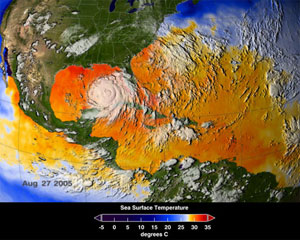Historical records of Atlantic hurricanes are accurate says study
Historical records of Atlantic hurricanes are accurate says study
Penn State University
November 28, 2007
EDITOR SUMMARY: Historical records of Atlantic hurricane activity are more accurate than previously believed, reports a study published in the current issue of Geophysical Review Letters. A statistical model based on “the climate factors that influence Atlantic tropical storm activity shows that the estimates currently used are only slightly below modeled numbers and indicate that the numbers of tropical storms in the recent past are increasing.”
Counting tropical storms that occurred before the advent of aircraft and satellites relies on ships logs and hurricane landfalls, making many believe that the numbers of historic tropical storms in the Atlantic are seriously undercounted. However, a statistical model based on the climate factors that influence Atlantic tropical storm activity shows that the estimates currently used are only slightly below modeled numbers and indicate that the numbers of tropical storms in the recent past are increasing, according to researchers.
“We are not the first to come up with an estimate of the number of undercounted storms,” says Michael E. Mann, associate professor of meteorology, Penn State, and director of the Earth System Science Center.

This image depicts a 3-day average of actual sea surface temperatures (SSTs) for the Caribbean Sea and the Atlantic Ocean, from August 25-27, 2005. Image Credit: NASA/SVS. Caves may reveal if global warming is causing stronger hurricanes Tree rings could settle global warming hurricane debate |
In the past, some researchers assumed that a constant percentage of all the storms made landfall and so they compared the number of tropical storms making landfall with the total number of reported storms for that year. Other researchers looked at ship logs and ship tracks to determine how likely a tropical storm would have been missed. In the early 1900s and before, there were probably not sufficient ships crossing the Atlantic to ensure full coverage.
The researchers report in the current issue of Geophysical Review Letters “that the long-term record of historical Atlantic tropical cyclone counts is likely largely reliable, with an average undercount bias at most of approximately one tropical storm per year back to 1870.”
The previously estimated undercounts of three or more storms are inaccurate.
“We have a very accurate count of Atlantic tropical cyclones beginning in 1944 when aircraft became common,” says Mann. “In the 1970s, satellites were added to that mix.”
With more than 60 years of accurate hurricane counts, the researchers, who included Thomas Sabbatelli, an undergraduate in meteorology and the Schreyer Honors College at Penn State, and Urs Neu, a research scientist at ProClim, Swiss Academy of Sciences, looked at other, independent ways to determine the number of hurricanes before 1944.
They looked at how the cycle of El Nino/La Nina, the pattern of the northern hemisphere jet stream and tropical Atlantic sea surface temperatures influence tropical storm generation by creating a model that includes these three climate variables. The information is available back to 1870.
The statistical model proved successful in various tests of accuracy. The model also predicted 15 total Atlantic tropical storms with an error margin of 4 before the current season began. So far, 14 storms have formed, with a little more than one week left in the season.
The model, trained on the tropical storm occurrence information from 1944 to 2006 showed an undercount before 1944 of 1.2 storms per year. When the researchers considered a possible undercount of three storms per year, their model predicted too few storms total. The model only works in the range of around 1.2 undercounted storms per year with the climate data available. The model was statistically significant in its findings.
“Fifty percent of the variation in storm numbers from one year to the next appears to be predictable in terms of the three key climate variables we used,” says Mann. “The other 50 percent appears to be pure random variation. The model ties the increase in storm numbers over the past decade to increasing tropical ocean surface temperatures.
“We cannot explain the warming trend in the tropics without considering human impacts on climate. This is not a natural variation,” says Mann.
“This . . . supports other work suggesting that increases in frequency, as well as powerfulness, of Atlantic tropical cyclones are potentially related to long-term trends in tropical Atlantic sea surface temperatures, trends that have in turn been connected to anthropogenic influences on climate,” the researchers report.













